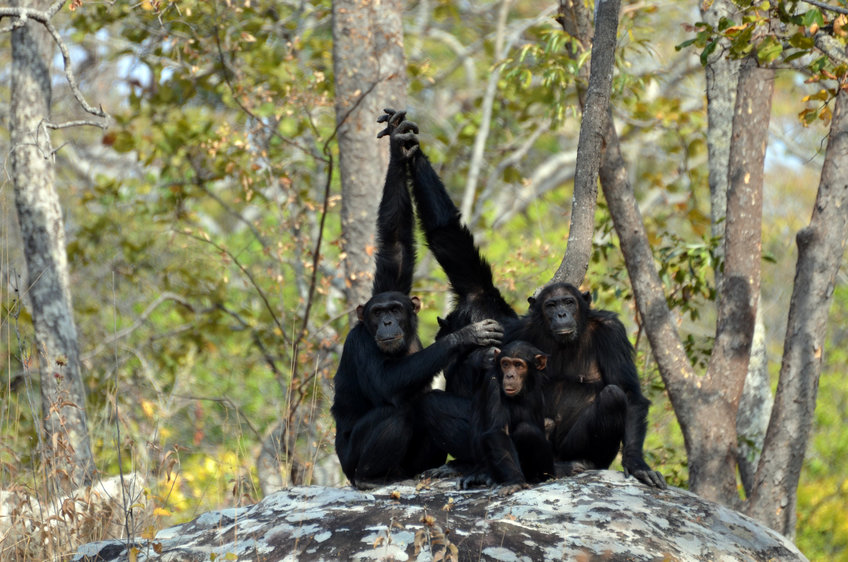Global change: a tight squeeze for African great apes
Researchers predict massive decline in the range of African great apes over the next 30 years
Climate change will drastically reduce the range of African great apes over the next 30 years. This was predicted by an international team of researchers with the participation of the German Centre for Integrative Biodiversity Research, the Max Planck Institute for Evolutionary Anthropology and the Martin Luther University Halle-Wittenberg. In various models, they calculated the effects of climate change, changing land use and human population growth on the future range of gorillas, chimpanzees and bonobos. The existing protected areas are not sufficient to preserve important populations in the long term, the researchers warn.

For their analysis, the authors compiled information on the occurrence of African great apes stored in the A.P.E.S. database of the World Conservation Union (IUCN). This database contains a remarkable amount of information on population status, threats and conservation measures for several hundred sites, collected over 20 years (http://apesportal.eva.mpg.de/).
The researchers quantified for the first time the joint effects of climate, land-use, and human population changes across African ape ranges for the year 2050 under best- and worst-case scenarios. “’Best case’ implies slowly declining carbon emissions and that appropriate mitigation measures will be put in place,” explains Jessica Junker, a postdoctoral researcher at the German Centre for Integrative Biodiversity Research and the the Martin Luther University and co-author of the publication. “’Worst case’ assumes that emissions continue to rise unchecked - in other words, business as usual.”
Under the best-case scenario, the authors predict that great apes will lose 85 per cent of their range, of which 50 per cent will be outside national parks and other areas protected by legislation. Under the worst-case scenario, they predict a 94 per cent loss, of which 61 per cent will be in areas that are not protected.
Existing protected areas are not enough
At present, higher altitudes are less attractive for some great ape species - mainly because of the reduced food supply. But climate change is changing that. Lowland areas are becoming warmer and drier, vegetation is shifting upwards. If great apes can physically move from the lowlands to the mountains, they may be able to survive and even increase their range - depending on the species and whether the best- and worst-case scenarios occur,” However, they may not be able to travel away from the lowlands in the time remaining between today and 2050.”
“By integrating future climate and land-use changes as well as human population scenarios, this study provides strong evidence for synergistic interactions among key global drivers constraining African ape distribution,” says lead author of the study Joana Carvalho, a postdoctoral researcher at Liverpool John Moores University's Faculty of Science. “The fact that the greatest range losses are expected to occur outside protected areas reflects the insufficiency of the current network of protected areas in Africa to preserve suitable habitats for great apes and effectively connect great ape populations.”
Habitats need to be connected
The results corroborate other recent studies showing that African ape populations and their habitats are declining dramatically. All African great apes are classified either as endangered (mountain gorillas, bonobos, Nigeria-Cameroon chimpanzees, eastern chimpanzees, and central chimpanzees) or critically endangered (Cross River gorillas, Grauer's gorillas, western lowland gorillas, and western chimpanzees) on the IUCN Red List of Threatened Species.
The authors argue that effective conservation strategies need to be planned for each species, taking into account both existing and proposed protected areas. This is where habitat suitability models could help in the establishment and management of protected areas. In addition, maintaining and establishing linkages and corridors between habitats predicted to be suitable in the future will be critical for the survival of the African great apes. Land use planning and climate change mitigation measures urgently need to be integrated into government policies in those countries where great apes live.
Global consumption of natural resources too high
“The global consumption of natural resources extracted from great ape ranges is one of the main causes of great ape decline”, says last author Hjalmar Kühl from the German Centre for Integrative Biodiversity Research and the Max Planck Institute for Evolutionary Anthropology. “All nations that benefit from these resources have a responsibility to ensure a better future for great apes, their habitats as well as the people living in them by advancing a more sustainable economy.”
WCS/ST,HK











